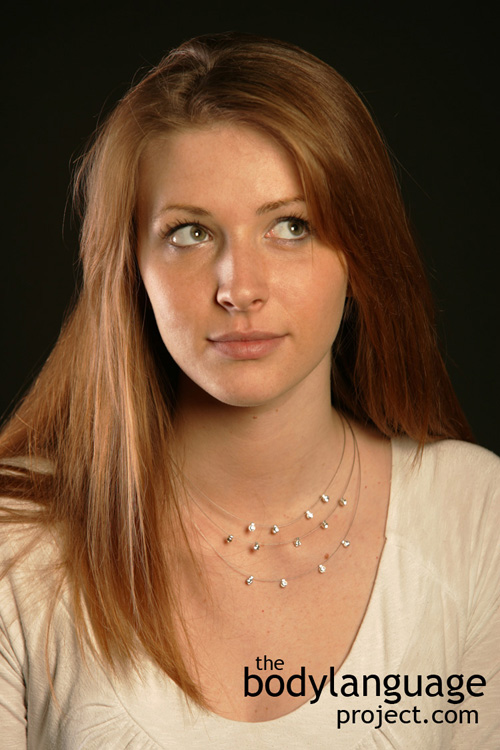Body Language of Eye Direction, NLP and Eye Access Cues
 Cue: Eye Direction, NLP, and Eye Access Cues.
Cue: Eye Direction, NLP, and Eye Access Cues.
Synonym(s): NLP, Eye Access Cues.
Description: Eye movements are a key component Neuro Linguistic Programming (NLP). NLP in this contest defines the process by which eye direction, that is, where the eyes look, can predict underlying thought process.
In One Sentence: The direction in which the eyes are cast is thought to provide clues to a person’s underlying thought process.
How To Use it: This cue is not something one can actively use to influence others as most people are not attuned to it’s meaning. Therefore, it is something we read in others rather than use ourselves. Although, if someone else is actively trying to read your body language (such as a police interrogator), and you know it, you might feign eye direction in order to confuse them.
Otherwise, eye direction is a cue best read in other people. See Meaning and/or Motivation.
Context: General.
Verbal Translation: “The direction I look outlines my thought process, so if you watch carefully you can figure out what kind of thoughts I’m accessing.”
Variant: N/A
Cue In Action: She was trying to figure out if her husband was telling the truth so she watched carefully when she asked him what the casino looked like. His eyes moved up and to the right. This told her that he was trying to construct a visual image. She was onto him.
Meaning and/or Motivation: For most right-handed people, eye movement up and to the left is a signal of accessing a visual memory.
Movement up and right means that a person is trying to construct a visual image.
Eyes either right or left, but still level, indicate an auditory process such as remembering sounds and words.
Down and left indicate internal dialogue or self-talk.
Down and right indicate a tactile or visceral feeling. When the eyes are straight ahead, unfocused or dilated they signal visual or any sensory information.
When reading someone’s eye access cues, be sure to formulate a baseline under normal conditions beforehand. Not all people respond to this rule in the same manner.
Cue Cluster: N/A
Body Language Category: Autonomic signal, Eye Language.
Resources:
Beck CE, Beck EA (1984) Test of the Eye-Movement Hypothesis of Neurolinguistic Programming: A rebuttal of conclusions. Percept Mot Skills. 58: 175–176.
Dilts, R.B., Grinder, J., Bandler, R., & DeLozier, J. 1979. Neuro-linguistic programming L Cupertino, CA: Meta Publications.
Ekman P (2001) Telling lies. Clues to deceit in the marketplace, politics, and marriage. New York: W. W. Norton & Company.
Elich M, Thompson RW, Miller L (1985) Mental imagery as revealed by eye movements and spoken predicates: A test of neurolinguistic programming. J Couns Psychol 32: 622–625
Gray R (1991) Tools for the trade: Neuro-linguistic programming and the art of
communication. Fed Probat 55: 11–16.
Galin, D. and Ornstein, R., 1974. Individual Differences in Cognitive Style – Reflective Eye Movements; Neuropsychologia, 12: 376-397.
Heap M (2008) The validity of some early claims of neuro-linguistic programming. Skeptical Intelligencer 11: 6–13.
Levine TR, Asada KJK, Park HS (2006) The lying chicken and the gaze avoidant egg: eye contact, deception and causal order.
Porter S, ten Brinke L (2010) The truth about lies: What works in detecting highstakes
deception? Legal and Criminological Psychology 15: 57–75.
Mann, Samantha ; Vrij, Aldert ; Nasholm, Erika ; Warmelink, Lara ; Leal, Sharon ; Forrester, Dave. The Direction of Deception: Neuro-Linguistic Programming as a Lie Detection Tool. Journal of Police and Criminal Psychology. 2012 27(2): 160-166.
Levine TR, Asada KJK, Park HS (2006) The lying chicken and the gaze avoidant egg: eye contact, deception and causal order.
Porter S, ten Brinke L (2010) The truth about lies: What works in detecting highstakes
deception? Legal and Criminological Psychology 15: 57–75.
Percival, Jennifer. Eye-opener: neuro-linguistic programming aims to offer techniques to enhance our everyday lives. Jennifer Percival attended a course to find out more.(perspectives). Nursing Standard. 2003 18(1): 20(2).
Patrington. 1997. NLP for Business Success: How to Master Neuro-Linguistic Programming. Management Research News. 20(8): 43.
Panksepp, J. 1998. Affective Neuroscience: The Foundation of Human and Animal Emotions. Oxford Univ. Press, New York.
Sandoval. 2001. Subtle skills for building rapport: using neuro-linguistic programming in the interview room. FBI law enforcement bulletin. 70(8): 1-635.
Skinner. 2003. Speaking the same language: the relevance of neuro-linguistic programming to effective marketing communications Source: Journal of Marketing Communications. 9(3): 177-192.
Sharpley CF (1984) Predicate matching in NLP: A review of research on the preferred representational system. J Couns Psychol 31: 238–248.
Sharpley CF (1987) Research findings on neurolinguistic programming: Nonsupportive data or an untestable theory? J Couns Psychol 34: 103–107.
Tosey, Paul; Mathison, Jane; Michelli, Dena. 2005. Mapping Transformative Learning: The Potential of Neuro-Linguistic. Journal Of Transformative Education. 3(2): 140-167.
Roderique – Davies, Gareth. Neuro-linguistic programming has no basis in neuroscience.(LETTERS)(Letter to the editor). Nursing Standard. 2010 24(33): 33(1).
Thomason TC, Arbuckle T, Cady D (1980) Test of the Eye Movement Hypothesis of Neurolinguistic Programming. Percept Mot Skills 51: 230.
Vrij A (2004) Invited article: why professionals fail to catch liars and how they can improve. Leg Criminol Psychol 9:159–181
Vrij A, Lochun SK (1997) Neuro-linguistic programming and the police: worthwhile or not? J Police Crim Psychol 12:25–31
Vrij A, Lochun SK (1997) Neuro-linguistic programming and the police: Worthwhile or not? Journal of Police and Criminal Psychology 12: 25–31.
Wiseman, Richard ; Watt, Caroline ; ten Brinke, Leanne ; Porter, Stephen ; Couper, Sara-Louise ; Rankin, Calum Lappe, Markus (Editor). The Eyes Don’t Have It: Lie Detection and Neuro-Linguistic Programming (The Eyes Don’t Have It). PLoS ONE, 2012, Vol.7(7), p.e40259.
Wood, John Andy 2006. NLP revisited: nonverbal communications and signals of trustworthiness. Journal of Personal Selling & Sales Management. 26(2): 197.
